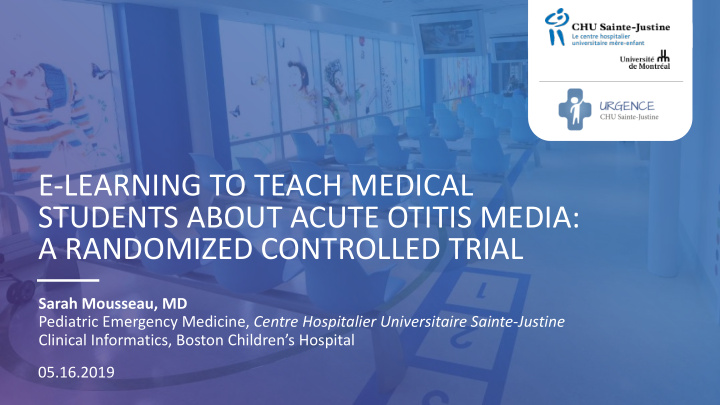



E-LEARNING TO TEACH MEDICAL STUDENTS ABOUT ACUTE OTITIS MEDIA: A RANDOMIZED CONTROLLED TRIAL Sarah Mousseau, MD Pediatric Emergency Medicine, Centre Hospitalier Universitaire Sainte-Justine Clinical Informatics, Boston Children’s Hospital 05.16.2019
We have no conflict of interest to disclose. DISCLOSURE
Acute otitis media Ear examination Trainees’ AOM #1 condition for Difficult to learn and diagnostic accuracy antibiotic prescription master Poor in children
How could we improve medical students’ ability to diagnose AOM?
Study objectives Measure the impact of an e-learning module on medical 1 students’ ability to diagnose AOM Assess which is the preferred learning modality 2 Evaluate if the e-learning module is associated with: § Improved knowledge on AOM § Better knowledge retention § Improved confidence
Methods Centre Hospitalier Universitaire Randomized controlled trial May 2017 – September 2018 Sainte-Justine 3 rd and 4 th year medical students Intervention: Control: e-learning module small-group lecture
Why e-learning? Cost- Easy update effective of content Interactive Accessible User- adaptable rhythm
+/- 30 minutes 1-hour duration E-learning module Standardized small- group lecture § Additional material: § Quizzes § Given by a trained pediatrician § Videos of different ear or pediatric emergency fellow conditions § Using the same PowerPoint § Five-minute video on the presentation pediatric otoscopic examination
Baseline characteristics of participants ( n = 139) E-learning group Small-group lecture group n = 69 n = 70 included in primary not included in included in primary not included in analysis, n (%) primary analysis, n (%) analysis, n (%) primary analysis, n (%) n = 45 n = 24 n = 38 n = 32 4th year medical 9 (20) 0 (0) 3 (8) 9 (28) students Male 17 (38) 8 (33) 14 (37) 10 (31) Previous teaching 27 (60) 18 (75) 24 (63) 20 (63) on AOM Previous ENT 15 (33) 6 (25) 13 (64) 10 (31) rotation Previous pediatric 19 (42) 4 (17) 14 (37) 12 (38) rotation
Mean diagnostic sensitivity, specificity and accuracy of ear exams among students who evaluated at least ten patient ears ( n = 83) E-learning group Lecture group Difference, % (intervention), % (control), % (95%CI) Mean sensitivity 67.7 4.1 (-9.0 to 17.3) 63.6 Mean specificity 79.0 80.8 -1.8 (-8.7 to 5.1) Mean diagnostic accuracy 76.5 76.4 0.1 (-6.2 to 6.4)
Secondary outcomes (n = 201) E-learning group Lecture group Difference n = 99 n = 102 (95% CI) Mean difference between 4.6 4.1 0.5 (-0.8 to 1.2) pre- and post-test Mean difference between 4.9 5.2 -0.2 (-1.2 to 0.8) post- and retention test Mean increase in confidence 3.6 4.1 -0.4 (-1.3 to 0.3) in ear exam technique, pre- port study, /10 Mean increase in confidence 2.9 2.8 0.1 (-0.7 to 0.9) in ear exam interpretation, pre-post study, /10
Preferred learning modality 86 students 62% 23% 15%
Conclusions No difference on clinical knowledge, clinical skills, and confidence in diagnosing AOM A majority of medical students preferred e-learning to the small-group lecture Future studies should focus on evaluating new teaching modalities for AOM that could have a real impact on future physicians.
Thank you ! Mrs. Maryse Lagacé Dr. Jocelyn Gravel Dr. Bich Hong Nguyen Mrs. Ramona Cook Dr. Maude Poitras Dr. Catherine Hervouet-Zeiber Mr. Pierre Guimond Dr. Annie Lapointe Dr. Marc Lebel Mr. Nicolas Guillemot
Recommend
More recommend